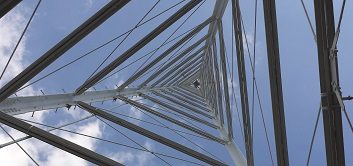When selecting analog snake cable, you usually have three gauge sizes from which to choose.
It used to be that most snakes were 22 AWG. But over the years, 24 AWG snakes have gradually taken over. In fact, the only reason you might still consider 22 AWG is ruggedness. If it’s out on the road or you’re going to be pulling through a particular torturous conduit, 22 AWG will last longer than 24 AWG. But 22 AWG will also be bigger overall and more expensive (more copper). The maximum pull tension on each 22 AWG conductor is 7 pounds, multiplied by all the conductors in the cable (and don’t forget the drain wires). For 24 AWG it’s 4 pounds. You do the math.
Now, 22 AWG is 17.5 ohms per 1,000 feet; 24 AWG is 27.7 ohms per 1,000 feet. Because resistance affects all frequencies equally, the difference in gauge size only means a slight change in signal level. Capacitance of the pairs, and the source impedance of the driving device, are much more critical to the actual analog performance of the snake. The 24 AWG has an added advantage. Lots of punch-down blocks are based on 24 AWG wire. Sure, they take 22 AWG or 26 AWG, but they’re made for 24 AWG.
You can also get 26 AWG snakes. They can be considerably smaller and a little cheaper. But you might not want to take them on the road. Installed, they would probably be fine, since they’re protected.
Cap it
You can tell the quality of a snake cable by the capacitance.
(click thumbnail)Very inexpensive snakes, made entirely of PVC, can be 50 picofarads per foot. Those with polyolefin on the wires will be around 30 pF/ft. Spend a little more and put polyethylene (PE) on the pair and you’re at 25 pF/ft. Spend a pile of money and get DuPont Teflon coating on the wires, and you’re at 20 pF/ft. Or you can get foamed polyethylene and get down to 13 pF/ft.
Those last are the best-performing analog cables in the world. The only thing that might confuse you is that they will say “digital audio” on the outside. But don’t worry. If that’s a problem, I will personally send you a bottle of rubbing alcohol. You can use that to rub off the word digital. Then the cable will work great for analog!
There’s one offshore manufacturer of snake cables that claims, in its catalog and on its Web page, that the pairs have a capacitance of 3.7 pF/ft. Since a capacitor is two metal plates (the wires) separated by a dielectric (in their case, polyethylene) you can easily calculate the distance between the wires necessary to get to that capacitance. In this case, 9.3 inches between the two wires. Conclusion: this is a misprint in their catalog (and Web page) that, oddly, has never been corrected for many, many years. Wonder why?
Don’t freak
One place you’ll see a lot of 26 AWG snakes is digital audio. Having pairs that are 110-ohm impedance and 13 pF/ft. means they’re going to be big. So digital snakes rarely get bigger than 24 AWG, and commonly get down to 26 AWG. Unlike analog, digital pairs have defined maximum distances. That’s because the AES has a spec for distance: a 2 V source signal and a 200 mV received signal. With that, the gauge of the wires, and the sampling rate of the audio, you can calculate the distance before you even manufacture the cable.
And speaking of 24 AWG wire, there are multipair cables out there that make great AES cables. They freak out a few grizzled broadcast engineers because I am talking about UTP, unshielded twisted pairs like Category 5e. And if you use Category 6 it only gets better. That stuff is 10–12 dB better in many crosstalk specs than 5e. And it’s usually 23 AWG, halfway between 22 AWG and 24 AWG, so it can go farther than regular 24 AWG snake cables. Four pairs in Cat-5e or Cat-6 mean four or eight channels of digital audio.
For digital audio, with a 44.1 kHz sampling rate, the bandwidth is 5.6448 MHz. For a 48 kHz sampling rate, the bandwidth is 6.144 MHz, so we have distance on the chart shown at 6 MHz, which pretty much covers both sampling rates you are likely to use.
But 800 feet with the small stuff will pretty much cover any application you have except for a huge stadium, auditorium or the 18th fairway. And, don’t worry, we have a solution for those extra-long applications. And that solution is coax snake … next time.
Previous articles in the Wired for Sound series are archived at radioworld.com.





